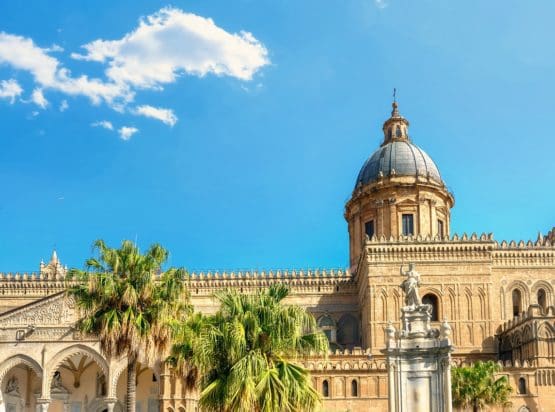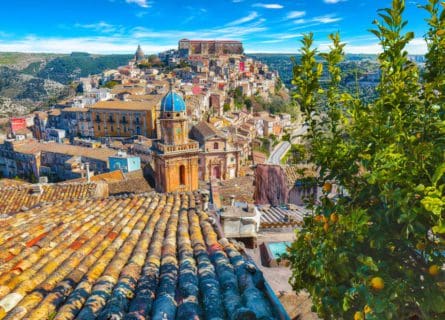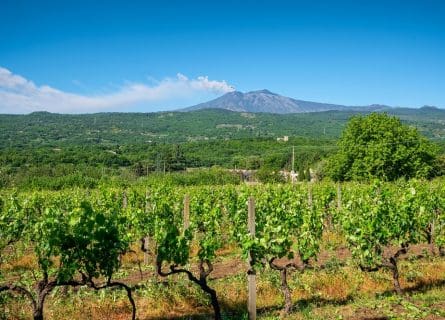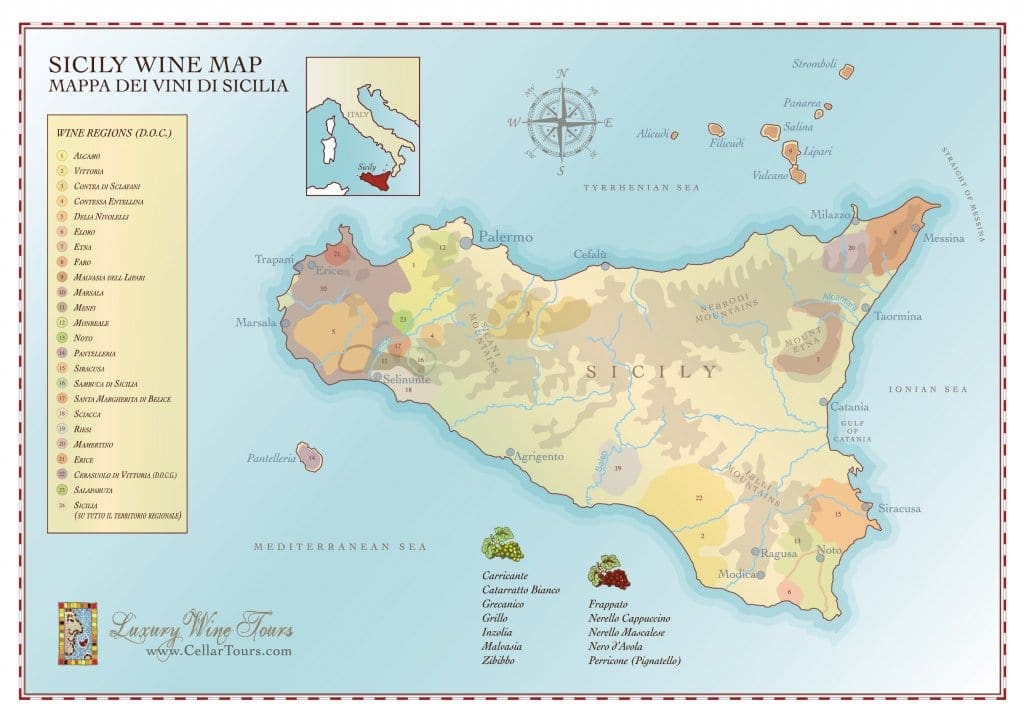Discover Palermo, Sicily's Enchanting Capital. Dive into Its Rich History, Irresistible Cuisine, and Vibrant Culture.
Read more
EXPLORE ALL OUR GUIDES TO THE BEST ITALIAN WINE REGIONS
Last updated: July 30, 2024
Sicily is home to Greek temples, dramatic coastlines, Baroque churches, and Mount Etna. There are stunning places to visit in Sicily, such as the Greek town of Taormina and the quintessentially Mediterranean Cefalù. It offers a surfeit of culture, intrigue, and culinary excitement. Yet, from our perspective, Sicily’s greatest asset is its vineyards; the Mediterranean’s largest island has become a modern source of exciting – and original – wines of great value. Granted, there are a smattering of French varieties cultivated in Sicily. However, its most stunning viticultural treasures are inevitably based on vines introduced by the Greeks: Nerello Mascalese, Inzolia, Grillo, and Nero’dAvola. The dark days of bulk production and insipid plonk are over. Today, we all gaze in awe at the Sicilian grape renaissance.

Sicily is a living, breathing museum with a treasure trove of architectural masterpieces that date back to the days of the ancient Greeks, Romans, and Moors. From the near-intact Greek temple of Agrigento to the Roman mosaics of Piazza Amerina, Sicily has experienced more historical earthquakes than any other Mediterranean island. Indeed, after 25 centuries of foreign intervention and conquest, Sicily proudly wears its battle scars!
Its first inhabitants were the Sicanians from North Africa – pre-Roman tribes who became integrated into the population during the colonization of Sicily by the Phoenicians; the capital Palermo was originally called Panormos or “port” by the Phoenicians in the 11th century BC. Next in line were the Carthaginians, a powerful civilization that established a base on the island in the 8th century BC. However, as their influence across the Mediterranean weakened, the Greeks seized an opportunity to conquer Sicily two centuries later. The city of Syracuse became one of the Greek Empire’s most important – and beautiful – bases in the region, eventually conquered by the forces of Rome in 211 BC. Vines were planted across the island, and Sicilian whites, invariably sweetened, became the toast of Italy. Yet Sicily’s internal politics remained highly fractious and schismatic – powerful opposing cities attempted to control the island throughout the Roman period. This only worsened after the Western Empire collapsed in AD 476, paving the way for endless wars and skirmishes.
The Vandals, Ostrogoths, and Byzantines controlled Sicily for a time before the Moorish invasion of AD 831. This was Palermo’s golden age, as the Arab rulers encouraged trade, farming, and mining across the island, generating significant wealth for the merchant classes. But the tee-total Arabs had little use for the vine, except for medicinal purposes. For a time, it looked as if Sicilian viticulture would become a shadow of its former glory.
However, Sicily’s rise to prosperity had not gone unnoticed. The Normans invaded in 1061 and made Palermo the center of their expanding empire – they subsequently conquered England in 1066. The Norman King Roger was a legendary bon vivant: he spent vast sums building ornate palaces and churches and replanting the vineyards of both eastern and western Sicily. In the 13th century, the kingdom passed to the German house of Hohenstaufen with little resistance from the Normans. Yet this stability was relatively short-lived; in the following years, Sicily passed to the Holy Roman Emperors, the Angevins, and the Aragonese before the Spanish Bourbons created the Kingdom of the Two Sicilies in 1734. This united Naples and Sicily in a union that survived until 1860. That year, Giuseppe Garibaldi planned the Italian unification in the town of Marsala, which is famous for the fortified wine of the same name.
In the late 20th century, Sicily’s bulk wine industry took flight. Gigantic wine factories were built in the late 1980s and early 1990s, designed to process vast volumes of wine as quickly – and cheaply – as possible. Thankfully, this paradigm was rejected in the early 2000s, as investors saw the untapped potential of Sicily’s incredible terroirs and grape varieties. Today, the island is a hotbed of fine wine led by pioneers like the Planeta and Franchetti families.

There is nowhere on earth quite like Sicily. The island is as rich and varied topographically as it is culturally – it is often said that it should be regarded as a continent rather than a mere island. You’ll find these terroirs and terrains to the west of Calabria, less than 20 kilometers from the mainland; there are plans to build a suspension bridge between Calabria and Messina, which is due to open in 2030. That will undoubtedly transform the regional economy and let even more consumers discover these eclectic and unique wines.
Yet, in many respects, Sicily is a very challenging place to grow vines and make wine. The southeastern tip of the island is further south than the city of Tunis in North Africa; temperatures regularly exceed 113°F in July and August. Thus, irrigation is a vital part of life here – the industry could not survive without it. On the plus side, though, Sicily is well suited to organic viticulture as fungal diseases are not a major issue here, except for the anomalous 2023 vintage. But inland, the landscape can be greener, partly because aspect and elevation can vary greatly in Sicily, particularly on the slopes of Mt. Etna.
Yes, indeed – the tallest active volcano in Europe has been transformed into Sicily’s leading producer of fine wine. Located in the northeastern part of the island, the summit rises to a spectacular 3000 meters above sea level, albeit no vines are planted that high! Today, many ambitious wineries brave the genuine risk of an eruption to fashion delectable red and white wines from a palate of indigenous and imported grapes. With its mix of altitudes and soil types, Etna is one of Europe’s last viticultural frontiers, replete with centenarian vines and ancient volcanic terroirs.
Most vines are grown on Etna’s northern, southern, and eastern slopes, with diurnal temperature variation helping to avoid excessive alcohol and flabby wines. The signature red grape, Nerello Mascalese, can thrive at up to 1000m on the slopes of Etna, yielding delicate, aromatic reds that recall the best Nebbiolo wines of Piedmont. It is often blended with Nerello Cappuccio and/or Frappato, an important ingredient in the Cerasuolo di Vittoria DOCG. It is renowned for its lively acidity and crunchy red fruit.
Meanwhile, some remarkably fresh and saline whites are made here under the auspices of the Etna Bianco DOC (Denominazione di Origine Controllata). The best are tangy, perfumed little beauties, not least the fragrant and downright brilliant wines from Grillo. This variety, traditionally used in the production of Marsala, yields one of Europe’s most elegant and impressive fine white wines, with a distinct bouquet of grapefruit, fennel, citrus, and minerals. However, some growers are convinced that Carricante is Etna’s leading style, responsible for the wonderfully acidic whites that can improve in bottle for over a decade. They have also rescued the ailing reputation of Catarratto, once the workhorse grape of the island that received a boost from global and Italian investors. It blends extremely well with Inzolia, another of Italy’s underrated white varieties.
The same could be said of Grecanico, another of Sicily’s hidden treasures: crisp and aromatic dry whites that the market consistently demands. Thankfully, sommeliers and influencers are helping to spread the word. Even Chardonnay can ascend to greatness in this arid climate – Franchetti and Planeta make the best examples.
But it’s a different story with Nero d’Avola. It was the first Sicilian variety to gain traction abroad, delivering a rich mouthful of concentrated red fruit and silky tannins. Many of the best examples are in the Eloro DOC, located at the island’s southeastern tip. In addition, the limestone terroirs of Eloro and Noto in the southeast and Agrigento near the south-central coast have shown a real affinity for the grape, yielding surprisingly elegant reds that occasionally veer into portiness. That said, Nero d’Avola vines are robust and can thrive in the driest climates; only Grenache displays the same level of resilience when facing prolonged heat and drought. In the vineyards of Cerasuolo di Vittoria (awarded DOCG status in 2005), Nero d’Avola is blended with Frappato, the yin to Nero’s yang.
Sweet Muscat is another worthy part of this story, most brilliantly realized on the volcanic island of Pantelleria. Back on the mainland, the Planeta and Nino Pupillo have done much to save Muscat from irrelevance, producing fresher, brighter styles in Noto and Siracusa. No less fine are the Malvasias of the Aeolian islands to the northwest of Messina. Neither can we omit Marsala from this discussion – this venerable fortified wine has sadly become an anachronism for most consumers, which is a crying shame, as the best Marsalas can rival the depth of Port and the finesse of Oloroso Sherry. Hopefully, its day will come.

The idea of a ‘Sicilian fine wine’ used to be a contradiction in terms. But no longer. Today, Sicilian wineries showcase the latest in modern equipment and techniques used to fashion an astonishing variety of wine styles, ranging from tangy, salty whites to voluptuous reds of immense power and structure. Yet unlike the vineyards of Tuscany and Piedmont, one of the most popular designations is the IGT (Indicazione Geografica Tipica) Sicily, which offers the freedom and flexibility many producers require. One of the island’s most important and influential associations is the Assovini Sicilia, comprised of 100 wine estates of varying sizes and ambitions. They account for a large volume of Sicily’s DOCG, DOC, and IGT wines, cultivating grapes in several different terroirs and subregions.
Grape varieties utilized are indigenous, Italian, or international, with Petit Verdot and Syrah proving to be the surprise hits of the recent decade. As a result, winemaking philosophies will vary dramatically in Sicily, so generalizations are impossible. The few consistency points revolve around vineyard climats – all of Sicily’s best zones benefit from cooling influences – and the minerality that defines these volcanic soils.
There is one caveat, however. The critical mass of aromatic white styles – Carricante, Grillo, and Inzolia – are fermented in low-temperature stainless steel. This creates very fruit-driven wines that consumers love and sommeliers demand, not least because every restaurant needs bottles that will fly out of the cellar! There is also a strong culture of blending on the island, and many of Sicily’s leading red wines are aged in wood. However, not everyone is a fan of oak, as purity and precision become ever-more desirable characteristics. Thus, winemakers like Occhipinti have recently moved away from oak maturation, preferring the neutral profile of aging wines in ceramic amphorae.
Moreover, the gentle oxygen ingress helps to soften the tannins, leading to a more textured and velvety mouthfeel. Some producers swear by it. Others regard 100% new French barrique as the panacea for more complexity, depth, and higher prices!
After a long stagnation and over-production, Sicily can now claim to be Italy’s most exciting wine region. As incredible as it sounds, the island once competed with Puglia for the title of Europe’s greatest bulk vineyard, churning out more than 10 million hectoliters of plonk, often shipped to northern Italy for blending. The larger companies and cooperatives had no desire – or motivation – to change this state of affairs. And so this Mediterranean paradise continued its steady decline while other regions like Campania and Umbria raced ahead. Something had to be done.
But who would be brave enough to challenge the status quo? As is often the case, a few pioneers took the initiative, and others soon followed. Indeed, the catalyst for this remarkable revival was the determination of several men, most notably Giuseppe Benanti, Angelo Gaja, Andrea Franchetti, Giovanni Rosso, and US wine importer Marc de Grazia, to overturn a historical tragedy, for there is nothing more depressing and unedifying than wasted potential – the squandering of such precious resources as exceptional soils and esoteric grape varieties. Thankfully and sensibly, given a shrinking global market for cheap wine, Sicily has become more concerned with quality than quantity. The main focus of their attention is the volcanic vineyards of Mt.Etna, now planted with a range of Sicilian grapes. These spectacular wines, infused with minerals and rock salt flavor, are among Europe’s finest.
Meanwhile, Sicily’s less famous (but equally important) subregions and appellations have also seen a shift toward domestic vines of late. In the early 21st century, the family firms of Tasca d’Almerita and Planeta did much to put modern Sicilian wine on the world map. This was achieved initially by showing that Sicily could produce world-class international varietals. And it clearly can!
Yet, many wineries are now much more interested in indigenous flavors than in the Merlot and Chardonnay that originally won them attention. This is a sensible move; many wine lovers complain their choices are limited and predictable. For some, the phrase ‘New World’ has become a byword for brands produced from a narrow spectrum of varieties: Merlot, Sauvignon Blanc, and Chardonnay. But too much predictability cloys in the end. Today, savvy consumers seek new experiences – they want to be moved out of their comfort zones. With a vine heritage as regionally varied as all its other assets, Sicily is uniquely positioned to cater to this growing demand.
Discover Catarratto: Sicily's Evolution from Workhorse to Premium White Wines, a Tale of Terroir and Innovation
Find out moreSicily's Carricante grapes thrive on Mount Etna's slopes, producing fresh, high-acidity white wines with complex aromas, a hallmark of Etna Bianco DOC.
Find out moreChardonnay is a green-skinned grape varietal native to the Burgundy wine region in France and one of the most popular varieties worldwide.
Find out moreDiscover Garganega Wines: From Sweet Elegance to Vivacious Dry Delights | Explore the Complexity of This Exceptional Grape
Find out moreGrillo grapes, once used in Sicilian Marsala, now produce aromatic, full-bodied dry whites, blending with Inzolia and Catarratto, offering a unique wine.
Find out moreSicilian Inzolia Wines: Freshness and Complexity Unveiled | Discover Italy's Vibrant Whites in Every Glass
Find out moreMuscat blanc is a white wine grape varietal popular in the Muscat d'Alsace, Moscato d'Asti and Beaumes-de-Venise regions.
Find out moreMalvasia Bianca, a historical grape from Greece, now thrives in Sicily and the Aeolian Islands, producing unique sweet wines.
Find out moreExplore Sicily's Frappato grape, a hidden gem known for its delicate charm, refreshing acidity, and distinctive flavors of berries and violets
Find out moreMerlot is the most cultivated grape in Bordeaux and closely related to Cabernet Franc
Find out moreExplore Nero d'Avola: Sicily's prized red grape, introduced by the Greeks, known for its rich, dark wines, and esteemed for its versatility.
Find out moreSicily's Jewel: Discover the Magic of Nerello Mascalese Wines - A Symphony of Terroir, Quality, and Elegance Awaits
Find out moreNerello Cappuccio, a dark-skinned grape from Sicily, is mainly used in Etna and Faro red wines. It's rarely a varietal wine, typically blending with the superior Nerello Mascalese. The grape offers soft, richly colored wines with cherry flavors. Thriving in Mount Etna's volcanic soils, it adds color perfume and softens Nerello Mascalese's edges in blends.
Petit Verdot is a full-bodied red wine grape varietal used in classic Bordeaux blends and originates in southwestern France
Find out moreSyrah is dark-skinned and perhaps the most underrated of the 'noble' red grape varieties.
Find out more
Sicilian gastronomy is the product of centuries of foreign occupation, creating one of Italy’s most diverse and multicultural food scenes. Witness fish couscous and pasta con le sarde (pasta with sardines, pine nuts, raisins, and fennel), sfincione (oily pizza topped with onions and caciocavallo cheese) and pasta alla norma, a heroic combination of pasta, basil, eggplant, tomato, and ricotta. The Arabs are also credited with introducing the Canoli, a crisp pastry shell filled with sweet ricotta. But Sicily’s greatest culinary masterpieces usually emanate from the sea. Involtini di pesce spada involves thinly sliced swordfish fillets rolled up and stuffed with breadcrumbs, capers, tomatoes, and olives. It’s a quintessential Sicilian dish that relies upon the best local ingredients money can buy.
A Guide to the gastronomy and Cuisine of Sicily: Read more
If you would like us to customize an exclusive luxury tour, contact us and let us know your travel plans. We offer luxury food and wine tours for private groups of a mininium two guests. In addition, all of our private, chauffeured tours are available year-round upon request.

